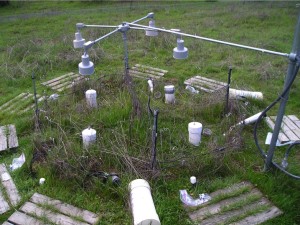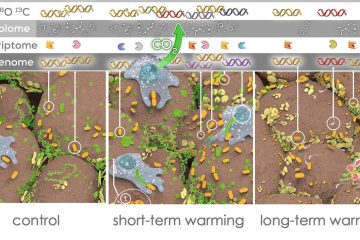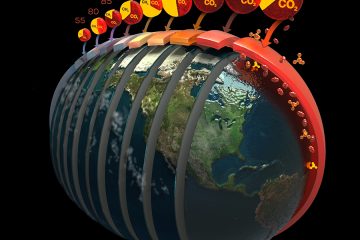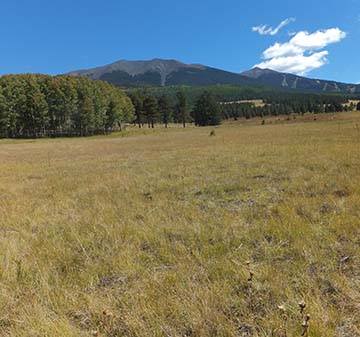Modification of Multiple Environmental Factors at Jasper Ridge
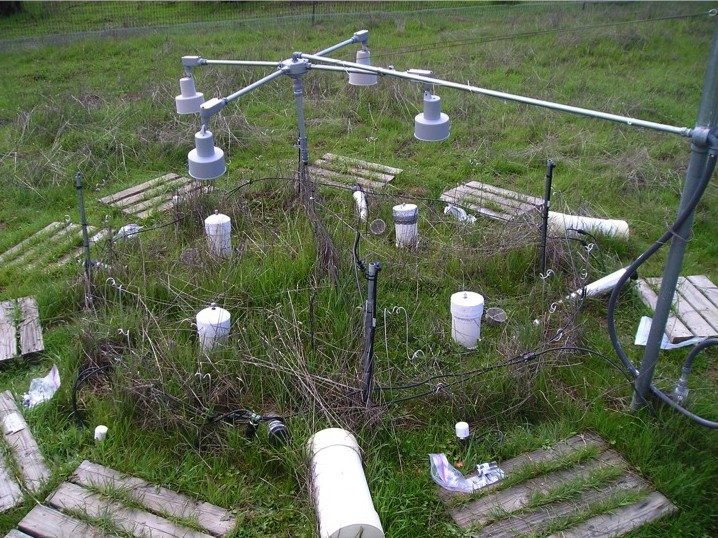
Overview
Most global change research focuses on individual components, but the environment is changing in multiple ways simultaneously. The Jasper Ridge Global Change Experiment seeks to find out how these combined changes will affect ecosystems. Researchers tested the response of a California grassland to:
- climate change
- elevated atmospheric carbon dioxide
- increased nitrogen pollution
- disturbance by wildfire (since 2003)
Students, faculty, and staff affiliated with the Ecosystem Science and Society Center have been active at the site since the experiment began in 1997.
Learn more details about the Jasper Ridge Global Experiment.
This research has been conducted by Bruce Hungate and Paul Dijkstra.
Recent results
Researchers have found that climate change, nitrogen deposition, and wildfire together boosted soil release of nitrous oxide, a potent greenhouse gas. Soils are the major source of nitrous oxide in the atmosphere, so increased soil emissions of nitrous oxide will accelerate global warming. This research shows the importance of considering simultaneous global changes: burning fossil fuels releases reactive nitrogen and raises the concentration of carbon dioxide in the atmosphere, in turn altering climate.
In some parts of the world, like the western United States, wildfires are also becoming more frequent and more intense. Alone, the treatments had little influence on nitrous oxide emissions, but the interaction with wildfire caused a huge burst of nitrous oxide production. Why? The combination of treatments favored bacteria in soil called dentrifiers, which convert nitrate into nitrous oxide. Wetter soils, more nitrate, and more carbon together promoted growth of denitrifying bacteria, microscopic organisms with global impacts. Increasing wildfire frequency and the changing climate could cause these soil microorganisms to release more nitrous oxide into the atmosphere, accelerating global warming.
Related publications
Niboyet A, Brown JR, Dijkstra P, Blankinship JC, Leadley PW, LeRoux X, Barthes L, Barnard RL, Field CB, and Hungate BA, 2011. Global change could amplify fire effects on soil greenhouse gas emissions. PLoS ONE, DOI: 10.1371/journal.pone.0020105
Barnard R, Le Roux X, Hungate BA, Cleland EE, Blankinship JC, Barthes L, Leadley PW, 2006. Several components of global change alter nitrifying and denitrifying activities in an annual grassland. Functional Ecology, 20:557-564.
Blankinship JC, Brown JR, Dijkstra P, Hungate BA, 2010. Effects of interactive global change on methane uptake in an annual grassland. Journal of Geophysical Research, 115, G02008, doi:10.1029/2009JG001097.
Brown JR, Blankinship JC, Niboyet A, van Groenigen KJ, Dijkstra P, Le Roux X, Leadley PW, Hungate BA, 2012. Effects of Multiple Global Change Treatments on Soil N2O Fluxes. Biogeochemistry 109: 85-100. DOI 10.1007/s10533-011-9655-2
Niboyet A, Barthes L, Hungate BA, Le Roux X, Bloor J, Fontaine S, Price PM, Leadley PW, 2010. Responses of soil nitrogen cycling to the interactive effects of elevated CO2 and inorganic N supply Plant and Soil 327: 35-47
Niboyet A, Le Roux X, Barthes L, Hungate BA, Dijkstra P, Blankinship JC, Brown JR, Field CB, Leadley PW, 2011. Testing interactive effects of global environmental changes on soil nitrogen cycling. Ecosphere 2:art56. Doi:10.1890/ES10-00148.1
Grants supporting this work
National Science Foundation, CAREER: Ecosystem responses to rising CO2 and climate change: feedbacks through the nitrogen cycle, 2001-2006, $781,574
